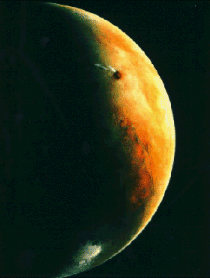The Planet
Mars
 Mars,
the "Red Planet", is named after the Roman god of war because it commonly
appears with a reddish tinge when viewed in our sky. It
has always held a fascination for those interested in the possibility of
life on other
planets.
In 1895 a professor of astronomy, Samual Leland Phelps, wrote in a book called
World Making that with a new 40 inch telescope being built by the
University of Chicago,
Mars,
the "Red Planet", is named after the Roman god of war because it commonly
appears with a reddish tinge when viewed in our sky. It
has always held a fascination for those interested in the possibility of
life on other
planets.
In 1895 a professor of astronomy, Samual Leland Phelps, wrote in a book called
World Making that with a new 40 inch telescope being built by the
University of Chicago,
"It will be possible to see cities on Mars, to detect navies in [its] harbors,
and the smoke of great manufacturing cities and towns... Is Mars inhabited?
There can be little doubt of it ... conditions are all favorable for life, and
life, too, of a high order. Is it possible to know this of a certainty?
Certainly." (quoted in Feb., 1973 National Geographic)
The adjacent image shows a Viking 2 image of Mars. There is no
evidence for the things that Professor Leland thought we would see with an
earth-based
telescope, but Mars is still of great interest to us, not the least reason
being that it may once have harbored conditions favorable to the evolution
of life.
 Mars,
the "Red Planet", is named after the Roman god of war because it commonly
appears with a reddish tinge when viewed in our sky. It
has always held a fascination for those interested in the possibility of
life on other
planets.
In 1895 a professor of astronomy, Samual Leland Phelps, wrote in a book called
World Making that with a new 40 inch telescope being built by the
University of Chicago,
Mars,
the "Red Planet", is named after the Roman god of war because it commonly
appears with a reddish tinge when viewed in our sky. It
has always held a fascination for those interested in the possibility of
life on other
planets.
In 1895 a professor of astronomy, Samual Leland Phelps, wrote in a book called
World Making that with a new 40 inch telescope being built by the
University of Chicago,